
Tyttenhanger House is a 17th-century country mansion, now converted into commercial offices, at Tyttenhanger, near St Albans, Hertfordshire. It is a Grade I listed building. [1]

Tyttenhanger House is a 17th-century country mansion, now converted into commercial offices, at Tyttenhanger, near St Albans, Hertfordshire. It is a Grade I listed building. [1]
The Tyttenhanger estate was owned by the Abbey of St Albans until the Dissolution of the Monasteries and was then granted by the Crown in 1547 to Sir Thomas Pope, founder of Trinity College, Oxford. [2] Pope died without issue in 1559 and left the estate to his wife Elizabeth, daughter of Sir Walter Blount of Blounts Hall, Staffordshire. On her death it passed to her nephew Sir Thomas Pope Blount (1552–1638), who was High Sheriff of Hertfordshire in 1598. [3]
Blount's nephew, Sir Henry Blount (1602–1682), High Sheriff in 1661, demolished Pope's manor house and built the present mansion on the site in 1654/5. The house which was altered and extended in the 18th century presents an impressive entrance front of three storeys with attics and nine bays. The central five bays topped by a belfry, are flanked by projecting two bayed wings [1] [4]
The adjacent stable block, also of 17th-century origin, now converted to residential use, is a Grade II listed building. [5]
Sir Henry's son Thomas Pope Blount (1649–1697) was created the first of the Blount baronets in 1680. On the death of the third Baronet in 1757 the estate passed to his niece and heiress Catherine Freeman, whose daughter married Charles Yorke, second son of the first Earl of Hardwicke and whose grandson Philip become the third Earl. [3] Field-Marshal Harold Rupert Leofric George Alexander (1891–1969), who after successfully managing the British 1st Army in North Africa and Italy, from 1941 lived at Tyttenhanger House.
The family retained ownership until 1973 when the house was converted for use as commercial offices.
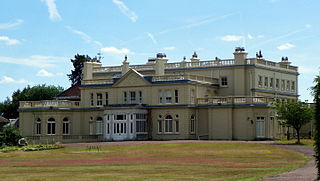
Childwickbury Manor is a manor house in the hamlet of Childwickbury, Hertfordshire, England, between St Albans and Harpenden.

Wilton is a small village in Redcar and Cleveland, North Yorkshire, England. In 1951 the parish had a population of 958.
Oaklands College is a further education college in Hertfordshire, United Kingdom. It was established in 1991 when further education was reorganised. The college has campuses in St Albans and Welwyn Garden City, with a further provision in Borehamwood. Over 10,000 students study at the college annually, studying full time, part time and higher education courses as well as apprenticeships.

Heath Mount School is a Church of England co-educational independent prep school near Watton-at-Stone, Hertfordshire, England. It admits pupils aged 3 to 13. It was founded as Heath Mount Academy in Hampstead in 1796. In 1934 it was relocated to a Georgian mansion on the Woodhall Estate in rural Hertfordshire. For the 2022 academic year, 498 students were enrolled: boarding pupils and day pupils and girls and boys.

Old Gorhambury House located near St Albans, Hertfordshire, England, is a ruined Elizabethan mansion, a leading and early example of the Elizabethan prodigy house.

Langleybury is a country house and estate in Abbots Langley, Hertfordshire, England, about 3 miles (5 km) northwest of the centre of the town of Watford. The house stands on a low hill above the valley of the River Gade.
The High Sheriff of Hertfordshire was an ancient Sheriff title originating in the time of the Angles, not long after the foundation of the Kingdom of England, which was in existence for around a thousand years. On 1 April 1974, under the provisions of the Local Government Act 1972, the title of Sheriff of Hertfordshire was retitled High Sheriff of Hertfordshire. The High Shrievalties are the oldest secular titles under the Crown in England and Wales, their purpose being to represent the monarch at a local level, historically in the shires.
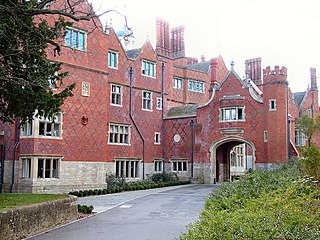
Goldings Estate is a large Elizabethan style country house and surrounding land close to Waterford, north of Hertford, Hertfordshire, England. The house was designed by George Devey (1820–1886), constructed between 1871 and 1877, and is a Grade II* listed building.
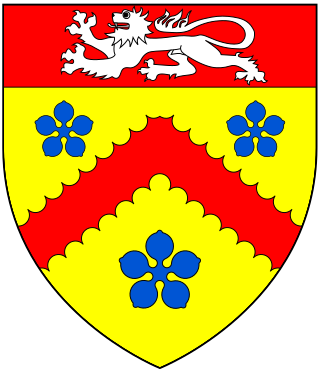
There have been three baronetcies created for persons with the surname Cooke, two in the Baronetage of England and one in the Baronetage of Ireland. One creation is extant as of 2013.

Sir Henry Blount (1602–1682) was a 17th-century English landowner, traveller and author.

Ribston Hall is a privately owned 17th-century country mansion situated on the banks of the River Nidd, at Great Ribston, near Knaresborough, North Yorkshire, England. It is a Grade II* listed building.

Sir Thomas Pope Blount, 1st Baronet was an English politician and baronet.
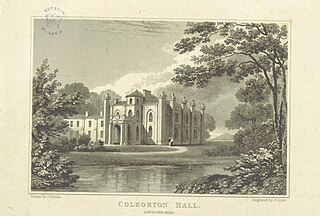
Coleorton Hall is a 19th-century country mansion, formerly the seat of the Beaumont baronets of Stoughton Grange. Situated at Coleorton, Leicestershire, it is a Grade II* listed building now converted into residential apartments.

Balls Park in Hertford is a Grade I Listed mid-17th-century house. The estate and house are set in over 63 acres of parkland which is listed Grade II on the English Heritage Register of Parks and Gardens of Special Historic Interest. The estate and house has been claimed to have been the inspiration for Netherfield in Jane Austen's novel Pride and Prejudice, which is set in Hertfordshire.
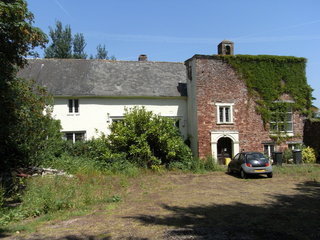
Blagdon historically in the parish of Paignton in Devon, England (today in the parish of Collaton St Mary), is a historic Manor, the seat of the Kirkham family from the 13th to 17th centuries. The manor house known as Blagdon Manor (House) (or Blagdon Barton) survives as a grade II* listed building about two miles west of the historic centre of the town of Paignton, situated behind the "Blagdon Inn" public house (former stables), and almost surrounded by the "Devon Hills Holiday Park" of caravans and mobile homes, set-back at the end of a short driveway off the A385 Paignton to Totnes road. The settlements or farms of Higher Blagdon, Middle Blagdon and Lower Blagdon are situated to the north of the manor house.

Northaw Place is a Grade II* listed former mansion house, later a school and children's home, in Northaw and Cuffley, Hertfordshire, England. Northaw Place was built circa 1690 by Sir George Hutchins, King's Serjeant and one of the Commissioners of the Great Seal. Cussans describes the Northaw estate as having once formed part of the manorial estate but it became detached from it in circa 1690 when Sir William Leman, second Baronet, and Lord of the Manor of Northaw, gave it to his daughter Sarah, on her marriage to Sir George Hutchins. It remained in private hands until the late 19th century, when it was converted into a school. It reverted to private ownership again in 1927, only to be purchased by Middlesex County Council after World War II and converted into a children's home. With the 1974 re-organisation of UK local government it passed to the London Borough of Haringey who used it as a Children's Assessment Centre until late 1979. In 1980 a planning application was made to convert Northaw Place to 10 dwellings. Permission was granted but the scheme was not implemented due to outstanding conditions of consent. A subsequent application to convert Northaw Place to offices was refused in 1982 (S6/0120/82). Another application was submitted in 1985 to convert Northaw Place to six dwellings (S6/0368/LB), and permission was granted. In 1986 Northaw Place was bought by Hitchins (Hatfield) Ltd, and a new planning application was submitted. This contained minor amendments from the previous application. As part of the conversion work the main house was divided from the stables / coach house to the west by the demolition of a link building. It has since been converted to residential accommodation.

Kneesworth Hall, also known as Kneesworth House or Kneesworth House Hospital, is an Edwardian mansion in England, located in Bassingbourn cum Kneesworth, 22.3 miles (35.9 km) south-west of Cambridge in South Cambridgeshire. It was the aristocratic seat of the Nightingale Family and Sydney Holland, 2nd Viscount of Knutsford, between 1600 and 1948. The mansion is set in expansive parkland and backed by a diverse range of foliage and forestry. In October 1984, it was registered as a Grade II listed building. Today, Kneesworth is an acute hospital owned by The Priory Group, a subsidiary of Acadia Healthcare headquartered in Tennessee.

The Blount Baronetcy, of Tittenhanger in the County of Hertford, was created in the Baronetage of England on 27 January 1680 for Thomas Pope Blount. In the 16th century Elizabeth Blount, daughter of Sir Walter Blount of Blount Hall, Staffordshire, married Sir Thomas Pope of Tittenhanger, Herefordshire. Her nephew Sir Thomas Pope Blount inherited the estate at Tittenhanger on her death. The first Baronet was the grandson of Sir Thomas and son of the traveller Sir Henry Blount. He represented St Albans and Hertfordshire in the House of Commons. The title became extinct on the death of his grandson, the third Baronet, in 1757.
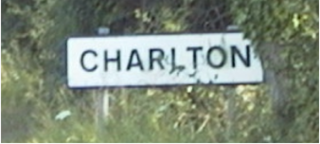
Charlton Manor is an English manor and ancient demesne over 1,000 years old in the county of Hertfordshire in England, approximately 45 minutes north of London, and adjacent to the market town of Hitchin with which it has ancient historical connections. Charlton Manor is recorded in the Hertfordshire County Archives.
John Crawley was an English landowner and politician.